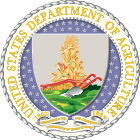- National Agricultural Statistics Service
-
The National Agricultural Statistics Service or NASS is the statistical branch of the U.S. Department of Agriculture[1]. NASS has 46 field offices throughout the United States and Puerto Rico and a headquarters unit in Washington, D.C.. NASS conducts hundreds of surveys and issues nearly 500 national reports each year on issues including agricultural production, economics, demographics and the environment. NASS also conducts the Census of Agriculture every five years.
Contents
History
During the Civil War, USDA collected and distributed crop and livestock statistics to help farmers assess the value of the goods they produced. At that time, commodity buyers usually had more current and detailed market information than did farmers, a circumstance that often prevented farmers from getting a fair price for their goods. Producers in today's marketplace would be similarly handicapped were it not for the information provided by NASS.
The creation of USDA's Crop Reporting Board in 1905 (now called the Agricultural Statistics Board) was another landmark in the development of a nationwide statistical service for agriculture. A USDA reorganization in 1961 led to the creation of the Statistical Reporting Service, known today as National Agricultural Statistics Service (NASS)[2].
The 1997 Appropriations Act [3] shifted the responsibility of conducting the Census of Agriculture from U.S. Census Bureau to USDA. Since then the census has been conducted every five years by NASS. The latest census was released on February 4, 2009 [4].
Surveys and reports
The primary sources of information for NASS reports are farmers, ranchers, livestock feeders, slaughterhouse managers, grain elevator operators and other agribusinesses. NASS relies on these survey respondents to voluntarily supply data for most reports.
NASS surveys are conducted in a variety of ways, including mail surveys, telephone interviews, online response, face-to-face interviews and field observations. Once the information is gathered and interpreted, NASS issues estimates and forecasts for crops and livestock and publishes reports on a variety of topics including production and supplies of food and fiber, prices paid and received by farmers, farm labor and wages, farm income and finances, and agricultural chemical use. NASS’s field offices publish local data about many of the same topics.
Importance of NASS data
Producers, farm organizations, agribusinesses, lawmakers and government agencies all rely on the information produced by NASS. For instance:
- Statistical information on acreage, production, stocks, prices and value is essential for the smooth operation of federal farm programs.
- Agricultural data are indispensable for planning and administering related federal and state programs in such areas as consumer protection, conservation and environmental quality, trade, education and recreation.
- NASS data helps to ensure an orderly flow of goods and services among agriculture’s producing, processing and marketing sectors.
- Reliable, timely and detailed crop and livestock statistics help to maintain a stable economic climate and minimize the uncertainties and risks associated with the production, marketing and distribution of commodities.
- Farmers and ranchers rely on NASS reports in making various production and marketing decisions, such as how much grain to plant, how much livestock to raise and when to buy or sell agricultural commodities.
- NASS estimates and forecasts are used by the transportation sector, warehouse and storage companies, banks and other lending institutions, commodity traders and food processors.
- The businesses that provide farmers with seeds, equipment, chemicals and other goods and services use the data when planning their marketing strategies.
- Analysts transform the statistics into projections of coming trends, interpretations of the trends’ economic implications and evaluations of alternative courses of action for producers, agribusinesses and policymakers.
See also
- Agricultural Resource Management Survey
- Census of Agriculture
- World Agricultural Supply and Demand Estimates
External links
United States government agencies involved in environmental science United States Environmental Protection Agency • National Aeronautics and Space Administration Department of the Interior Department of Commerce Department of Energy Energy Efficiency and Renewable Energy • Energy Information Administration • Federal Energy Regulatory Commission • Biological and Environmental Research • Office of Environmental ManagementDepartment of Agriculture Farm Service Agency • Foreign Agricultural Service • Risk Management Agency • Food Safety and Inspection Service • Forest Service • Natural Resources Conservation Service • Rural Business-Cooperative Service • Office of Community Development • Rural Housing Service • Rural Utilities Service • Food and Nutrition Service • Center for Nutrition Policy and Promotion • Agricultural Marketing Service • Animal and Plant Health Inspection Service • Grain Inspection, Packers and Stockyards Administration • Agricultural Research Service • Cooperative State Research, Education, and Extension Service • Economic Research Service • National Agricultural Statistics Service • Agricultural Stabilization and Conservation ServiceDepartment of Health
and Human ServicesStatistical agencies of the United States Federal Government Department of Labor Department of Commerce Department of Energy Department of Agriculture Economic Research Service · National Agricultural Statistics ServiceDepartment of Transportation Department of Justice Department of Defense Department of Education Department of Housing and Urban Development Department of Homeland Security Department of Health and Human Services Categories:- National statistical services
- United States Department of Agriculture agencies
- Statistical organizations in the United States
Wikimedia Foundation. 2010.


